Evaporative Cooling Process is a cooling technique that uses water as its refrigerant, which is a significant advantage and makes it environment friendly.
Evaporative cooling works on the principle of evaporation of water. Water takes the heat from the incoming air and evaporates. The evaporation cools down the air and also increases its humidity. Because of low energy consumption this method of cooling is very popular in hot and dry climates.
The secretion of sweat from human body and resultant cooling of the body on evaporation is an example of evaporative cooling. This natural phenomenon of controlling body temperature is prevalent among all mammals.
In the evaporative cooling process, a fan or a blower is used to draw the warm air from outside and it is passed though wet pads which provide enough surface area for water to evaporate. The pads are normally made of material such as Aspen Wool or paper celluloid pad.

Image Credit:hvacinvestigators.com
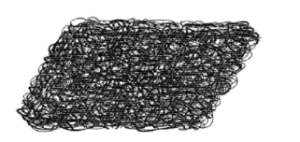
Material for Pads: Aspen Wool Fibre.
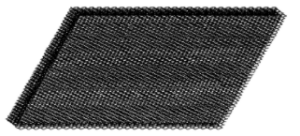
Material for Pads: Paper Celluloid pad
Image Credit: researchgate.net
Like the conventional air conditioning system, the evaporative coolers too can be installed either as standalone machine or can be ducted. The evaporative coolers can be roof mounted, window mounted or ground mounted. Roof mounted is the preferred choice when ducting system is to be installed.
Since the system requires continuous make-up of water as it is being continuously evaporated, the quality of water is of paramount importance. If hard water is used, it shall cause scaling on metal parts. The scale deposit also takes place in the pads and over a period of time. This leads to uneven distribution of water over the pads, leading to hot spots and resultant efficient cooling. To tackle the issue of high mineral build-up in the re-circulating water, a water bleed-off line is installed to drain a part of water on continuous/intermittent basis.
One of the other application of evaporative cooling, which is employed in large scale is in the industrial cooling towers. In a cooling tower, the circulating water which picks up heat from the industrial systems/processes through heat exchangers is rejected into the atmosphere.
The heat rejection process is achieved by spraying the water over a large area by means of water distribution nozzles and piping system and the same is collected in a basin below. Based on the design of the cooling tower, the water evaporation is induced through natural convection or though a induced draft fan. Depending on the delta difference between the temperature of incoming water and atmosphere along with the relative humidity, a temperature drop of 6-10° C can be achieved in a cooling tower.
What is Evaporative Cooling?
Evaporative cooling can lower the air temperature using much less energy than the typical refrigeration process.
In this process, water gets evaporated in a stream of air and change from liquid to vapor phase occur. Sensible heat from the surrounding air is used in the process as necessary latent heat for the evaporation of water—the loss of energy from air results in a reduction in air Temperature.
This technique of cooling is energy efficient as well as highly sustainable, which ensures an industrious, comfortable and hygienic working environment inside an office building, production or distribution centers. In comparison to another mechanical cooling system, the Evaporative Cooling method uses significantly less amount of energy but resulting the same or more efficient cooling capacity as the traditional cooling methods.
The Evaporative Cooling system does not use warm polluted indoor air, which results in 100% fresh and pollution-free air inside a room or building.
The evaporative cooling however has its disadvantages, the primary being, reduced effectiveness when the atmospheric humidity is high. In high humidity conditions, or when relative humidity is close to 100% water evaporation becomes difficult as atmosphere is already saturated with moisture.
Hence, the cooling capacities go down drastically. More importantly, when evaporative coolers are employed in residential areas located in hot humid conditions, the resultant higher moisture content of the air makes the environment more uncomfortable for human occupation. Maintaining a continuous high humidity levels also leads to formation of molds in household items.
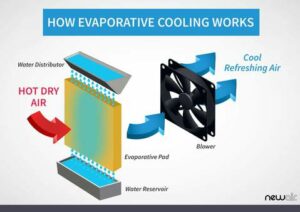
Evaporative Cooling, Image Credit: newair.com
Different techniques of Evaporative Cooling are (1)Direct,(2) Indirect and(3) Direct/Indirect or Two-Stage Evaporative Cooling.
What is Direct Evaporative Cooling system?
Direct Evaporative cooling is defined as the system, where the incoming outside air blown through a humidifier where the moisture is added to reduce its temperature.
In this cooling system, outside air is blown over a wet surface, generally cellulose Honey cooling pads. Moisture present on the surface gets evaporated and lowers the air temperature. With the help of a blower, cooled air is circulated throughout the required space.

Image Credit: evapoler.com
In direct cooling, all the cooling effect achieved by evaporation of water is transferred to the space being cooled. There is practically no loss of cooling duty. Considering the fact that, 1000 Kg of water requires around 680 KW of energy to transform it from liquid to vapor phase, the cooling effect achieved is significant.
The system however has its limitations as the cooling efficiency drastically reduces with increase in the humidity of incoming air. This is because if the incoming air is already saturated with moisture, it’s potential to add additional moisture decreases and so it’s cooling effect.
How does Direct Evaporative Cooling work?
Direct evaporative cooling or single-stage cooling increases the moisture content of the air stream until its saturation point.
The details of the working of a Direct Evaporative Cooling system is as follows:
- Construction-wise it is very simple, consisting of a fan, thick pad, a water reservoir etc.
- Air from outside is pulled with the help of a large fan through a thick sponge-like wet pad.
- The main function of the thick pads is to absorb water and large number of layers of these pads increases the surface area. This thick pad is also called as a humidifier unit. Hot air evaporates the water molecules present on the large surface area provided by the pads in the humidifier and as a result the air temperature inside the humidifier drops. The temperature drop depends upon the humidity or moisture content of incoming air and if the air is hot and dry, a temperature drop of upto 20°C can be achieved.
- It is the simplest and most popular cooling system available, which can be used as the most economical alternative for air conditioning requirements, preferably in certain climates.
- Open windows are provided to circulate the cool air. Ceiling vents to a ventilated attic can also be used.
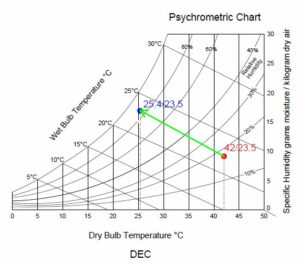
Image Credit:evapoler.com
The amount of cooling that can be achieved can be calculated based on the wet and dry bulb temperature of the incoming air. These temperatures are required to calculate the humidity of the incoming air by the help of a psychometric chart. As shown in the picture above, the blue point denotes a dry bulb temperature of 25.4°C and wet bulb temperature of 23.5°C.
The low difference between these two temperatures indicates lower cooling potential of incoming air through evaporative cooling. Hence this point is located above the 80% relative humidity curve. On the other hand, the red point denotes higher evaporative cooling potential of the incoming air with respective dry and wet bulb temperatures of 42° and 23.5° C. Understandably the specific humidity lies in the lower range (below the 20% Curve).
What is Indirect Evaporative Cooling system?
In Indirect Evaporative Cooling system, the stream of air being supplied to cooled space and doesn’t come in contact with water.
This process implements a heat recovery unit, wherein the air being cooled exchanges heat with water which is evaporated on the other side of the metal surface. Since there is no direct contact with water, air is thus cooled without the addition of any moisture content.
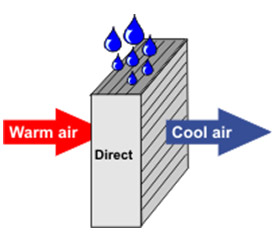
Image Credit: evapoler.com
An indirect evaporative cooling system employs various techniques to achieve evaporative cooling on the water side. In one type, the air to be cooled is passed through a series of metal tubes, which are sprayed with water. Heat from the hot air evaporates the water on the metal surface thus producing the cooling effect.
How does Indirect Evaporative Cooling work?
In Indirect Evaporative Cooling process humidity of air is not increased.
Indirect Evaporative Coolers use the surrounding air to cool the inside temperature without allowing the direct mixing of external and internal airstreams. The moisture generated during evaporative cooling is expelled with the exhaust air and the air stream being sent to the cooling space is cooled by means of an air-to air heat exchanger.
There are variations in design based on above concept.

Image Credit: 2CTsinghuaUniversity.Indirectevaporativecooling..pdf
A typical set-up for indirect evaporative cooling system is shown in the above image. In this system, the inlet air is separated into two parts. One part is passed through the humidifier and then passed through a heat exchanger to the exhaust. The other part of inlet air stream exchanges heat with the cool moist air before being supplied to the space being cooled.

Image Credit: indirect-evaporative-air-conditioning-commercial-emea
In this configuration, the air to air heat exchanger consists of alternate wet and dry tubes. The inlet air enters the dry tubes and a part of it is released to the space being cooled. Another part is pushed back to the wet tubes, where evaporative cooling takes place. The moist cooled exhaust air exchanges heat with incoming hot inlet air and provide the cooling effect.
This method reduces dry bulb and wet bulb temperature, and the air is cooled down without gaining any extra humidity. Hence, this method of evaporative cooling is suitable for services where low humidity is desired.
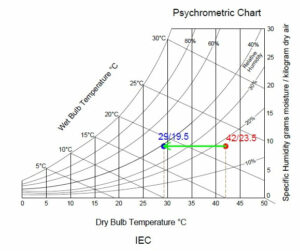
Image Credit:evapoler.com
As shown in the psychometric charts above, with indirect evaporative cooling there is no change in specific humidity of air being cooled although there is significant reduction in both dry as well as wet bulb temperature.
What is the difference between Direct and Indirect Cooling?
The effectiveness of both Direct and Indirect Cooling depends on the limit to which dry bulb temperature exceeds the wet-bulb temperature of the supply air.
Differences between Direct and Indirect Evaporative Cooling are:
Here dry bulb represents the ambient or surrounding air temperature measured with the help of a thermometer, and the wet bulb is the lowest temperature level of the air attained after evaporative cooling of air.


Direct and Indirect Evaporative Cooling, Image Credit: munters.com
Evaporative Cooling examples
Certain examples of Evaporative Cooling are listed below:
- In summer, water in an earthen pot remains cool because the pot has fine pores through which water inside the pot gets evaporated.
- When we sweat, the water particles on our body surface gets evaporated, and we feel a comfortable temperature.
- Recovery of salt from seawater is also made by the natural evaporation process.
- When we apply nail polish remover on our nails, we feel colder since acetone in our nail paint remover absorbs heat from our body and evaporates.
Advantages of Evaporative Cooler
Evaporative Cooler or Swamp Cooler is an electric appliance used widely to reduce ambient temperature through humidification.
The major advantages of evaporative cooler are:
- In comparison to usual air conditioning system more affordable and at same time less energy is consumed.
- When compared to an air conditioner, the installation cost is very less and due to the simplicity in construction the maintenance cost is very less. No compressor as well as no refrigerant are used, chief components of a cooler are a fan and a water pump. No skilled or professional service provider are required as in case of an air conditioning system.
- These coolers are working best in dry and desert areas because they increase the moisture content in air. Popularly known as Desert Cooler. Several health problems associated with dry weather like dryness of nose lining, throat etc are resolved due to the use of Evaporative Coolers.
- Maintain a natural humidity level which is beneficial for wood furnitures.
Drawbacks of Evaporative Cooler
Evaporative Coolers are not suitable for humid climates and for rainy seasons.
The drawbacks of Evaporative Coolers are mainly due to the negative impacts of too much humidification.
- Using Coolers for long period of time or in a hot and humid weather results respiratory issues.
- Temperature control is very limited. Not as effective as air conditioner in terms of cooling.
- Due to excessive humidity promote the growth of dust mites, molds etc.

I am Sangeeta Das. I have completed my Masters in Mechanical Engineering with specialization in I.C Engine and Automobiles. I have around ten years of experience encompassing industry and academia. My area of interest includes I.C. Engines, Aerodynamics and Fluid Mechanics. You can reach me at